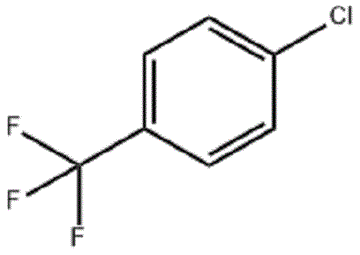English Synonyms:
4-Chlorobenzotrifluoride,98%250ml;4-Chlorobenzotrifluoride,98%25ml;thethreefluorinechlorinetoluene;forchlorobenzotrifluoride;alpha,Alpha,Alpchemicalbookha-Trifluoro-4-Chlorotoluene;benzene,1-Chloro-4-(Trifluoromethyl)-;para- Chloro-Alpha,Alpha,Alpha-Trifluorotoluene;para-Chlorobenzotrifluoride
p-Chlorotrifluorotoluene Properties
| Melting Point | -36 °C (lit.) |
| Boiling Point | 136-138 °C (lit.) |
| Density | 1.353 g/mL at 25 °C (lit.) |
| Vapor Pressure | 10hPa at 25℃ |
| Refractive Index | n20/D 1.446(lit.) |
| Storage conditions | Flammables area |
| Solubility | 56mg/l |
| Form | liquid |
| Color | Transparent and colorless |
| Proportion | 1.353 |
| Odor | Aromatic Smell |
| Water solubility | 29 ppm (23 ºC) |
| Merck | 14,2126 |
| BRN | 510203 |
P-Chlorotrifluorotoluene Usage and Synthesis
Introduction:
4-Chlorobenzotrifluorotoluene (4-chlorobenzotrifluorotoluene) is a colorless and transparent liquid with the smell of halogenated benzene. This compound is insoluble in water and miscible with benzene, toluene, ethanol, ether, halogenated hydrocarbons, etc.
Application:
Para-Chlorotrifluorotoluene Is an Important Organic Synthesis Intermediate. The Fluorine Atoms It Contains Give It Special Activity. It Is Widely Used in Fine Organic Synthesis Fields Such as Medicines, Pesticides, And Dyes. P-Chlorotrifluorotoluene Is a Key Intermediate for the Synthesis of Various Fluorine-Containing Pesticides and Herbicides in Pesticides. At Present, The Most Commonly Used Ones Are the Synthesis of Trifluralin, Trifluralin, Flufenacet, And Fluiofenacet. Ethers, And Carboxyfluoroether Herbicides, Etc.
Chemical properties:
This product is liquid at room temperature, m.p.-36℃, b.p.139.2℃, n20D 1.4460, relative density 1.353, f.p.117℉ (47℃), soluble in organic solvents such as benzene and toluene.
Usage:
p-Chlorotrifluorotrifluoride is an intermediate of the herbicides trifluralin, oxyfluorfen, acifluorfen, fomesafen, carboxyfluorfen, lactofen, etc.
Usage:
This product is used as trifluralin, trifluralin, trifluralin, flufenacet, fluiofen, and carboxyfluoride herbicides, etc.; it can also be used in synthetic medicine; in addition, it can also be used in the dye industry.
Usage:
Used as intermediates for pesticides, medicines, dyes, etc.
Production Method:
It Is Obtained by Side-Chain Photochlorination and Liquid-Phase Fluorination of P-Chlorotoluene: Chlorination: Put P-Chlorotoluene into a Photochlorination Reactor, Heat to 120-150°c, And React with Chlorine Under Fluorescent Lamp Irradiation. Take a Trace Amount of the Reaction Solution Every 10-15 Minutes for Gas Chromatography Analysis. Stop the Reaction When the P-Chlorotrichlorotoluene Content Is Greater Than 90%. The Product Is Distilled Under Reduced Pressure to Obtain P-Chlorotrichlorotoluene. The Yield Is 90-95%. Fluorination: Put P-Chlorotrichlorotoluene into the Fluorination Reaction Kettle, And Add 4-5 Times Anhydrous Hydrogen Fluoride at a Molar Ratio. After Raising the Temperature, React at 1.9-2.4mpa Until the Reaction Pressure No Longer Rises. The Hydrogen Chloride Gas Released During the Reaction Is Absorbed by Alkali, And the Reactants Are Neutralized and Steam Distilled to Obtain Crude Products. Then Distill Under Normal Pressure to Obtain P-Chlorotrifluorotoluene Liquid with a Boiling Range of 138-140°c. The Yield Is 80-90%.
Production Method:
The Preparation Method Is to Add P-Chlorotrichlorotoluene to the Fluorination Reactor, Pass the Condenser Through Frozen Brine to Cool It, Press the Measured Liquid Hydrogen Fluoride from the Cylinder to the Fluorination Reactor with Dry Air, Then Add the Catalyst, Close the Regulating Valve, Stir and Heat up the Reaction. The Hydrogen Fluoride Produced by the Reaction Condenses and Refluxes Along with the Volatile Hydrogen Fluoride and Organic Matter. The Liquid Hydrogen Fluoride Recovered by Condensation Is Stored in the Recovery Tank. After the Reaction, The Fluorinated Product P-Chlorotrifluorotoluene Enters the Distillation Kettle and Is Heated and Refined Under the Vacuum System. Distillate Products.


